Analyzing the Role of Zaha Hadid in Modern Architecture
VerifiedAdded on 2022/09/12
|32
|7517
|21
Essay
AI Summary
This essay delves into the significant role of Zaha Hadid in shaping modern architecture. It begins with an introduction to the context of iconic architectural works and the evolution of design, highlighting the influence of technology and modernism, particularly Deconstructivism. The essay then focuses on Hadid's contributions, including her spatialization of Suprematism and her innovative use of materials and forms. It examines her iconic buildings, such as the Bergisel Ski Jump, and how her designs have embraced the concept of Deconstructivism. The essay further explores the influence of Russian constructivism on Hadid and provides an analysis of her projects, emphasizing her ability to create functional and aesthetically pleasing structures. The paper concludes by underscoring Hadid's vision of architecture and its impact on urban life. The essay references various sources to support the analysis of Hadid's architectural style and its impact on modern architecture.
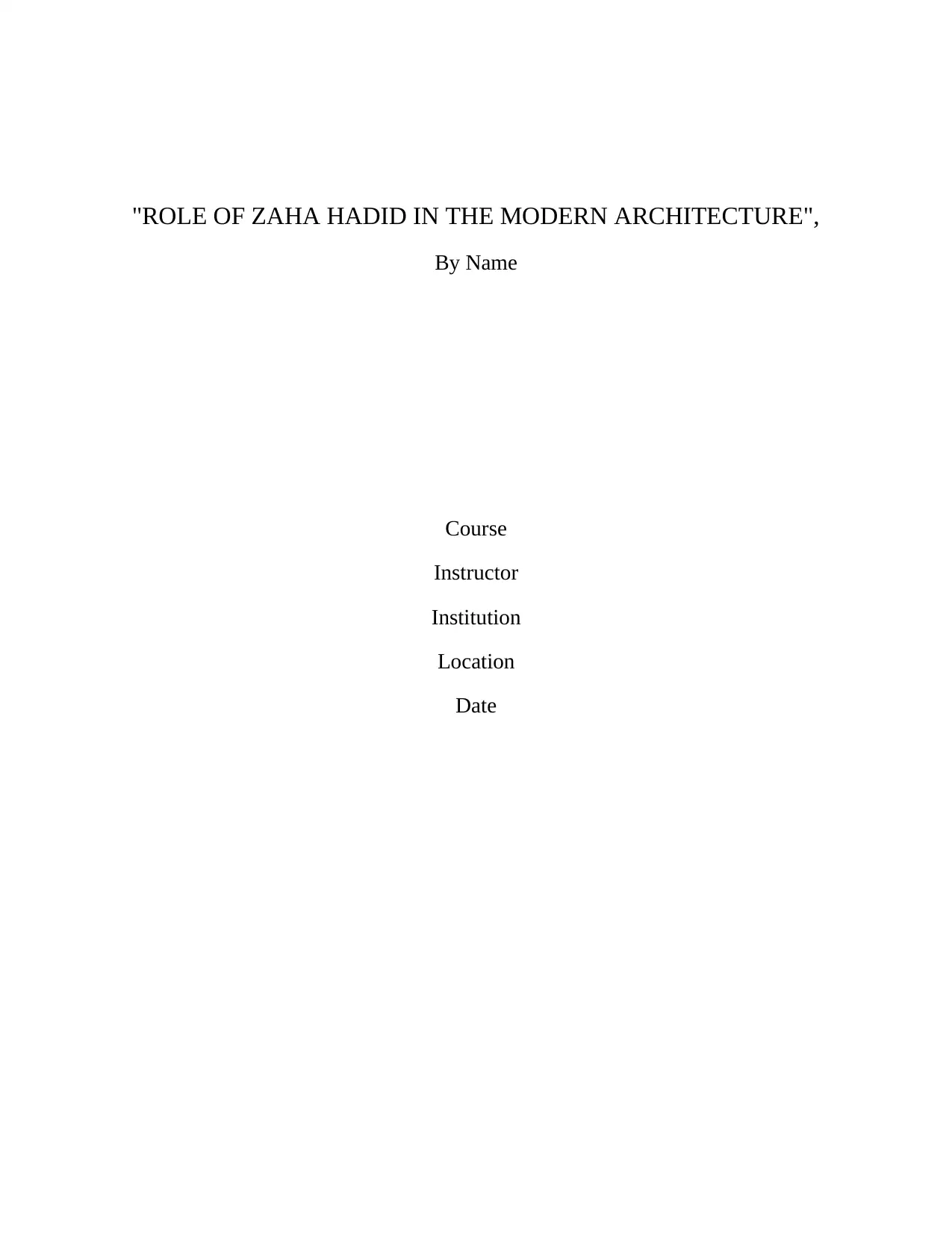
"ROLE OF ZAHA HADID IN THE MODERN ARCHITECTURE",
By Name
Course
Instructor
Institution
Location
Date
By Name
Course
Instructor
Institution
Location
Date
Paraphrase This Document
Need a fresh take? Get an instant paraphrase of this document with our AI Paraphraser
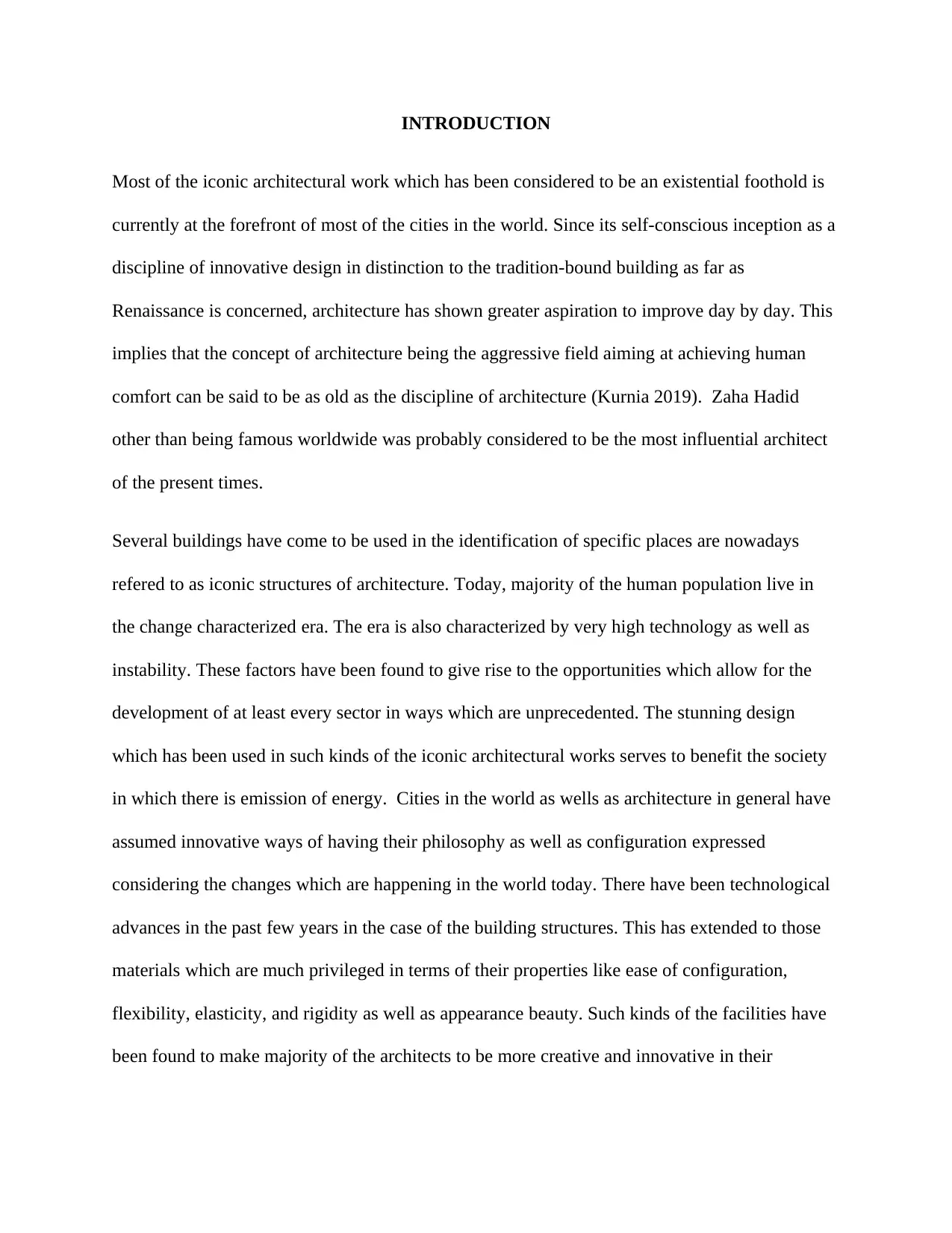
INTRODUCTION
Most of the iconic architectural work which has been considered to be an existential foothold is
currently at the forefront of most of the cities in the world. Since its self-conscious inception as a
discipline of innovative design in distinction to the tradition-bound building as far as
Renaissance is concerned, architecture has shown greater aspiration to improve day by day. This
implies that the concept of architecture being the aggressive field aiming at achieving human
comfort can be said to be as old as the discipline of architecture (Kurnia 2019). Zaha Hadid
other than being famous worldwide was probably considered to be the most influential architect
of the present times.
Several buildings have come to be used in the identification of specific places are nowadays
refered to as iconic structures of architecture. Today, majority of the human population live in
the change characterized era. The era is also characterized by very high technology as well as
instability. These factors have been found to give rise to the opportunities which allow for the
development of at least every sector in ways which are unprecedented. The stunning design
which has been used in such kinds of the iconic architectural works serves to benefit the society
in which there is emission of energy. Cities in the world as wells as architecture in general have
assumed innovative ways of having their philosophy as well as configuration expressed
considering the changes which are happening in the world today. There have been technological
advances in the past few years in the case of the building structures. This has extended to those
materials which are much privileged in terms of their properties like ease of configuration,
flexibility, elasticity, and rigidity as well as appearance beauty. Such kinds of the facilities have
been found to make majority of the architects to be more creative and innovative in their
Most of the iconic architectural work which has been considered to be an existential foothold is
currently at the forefront of most of the cities in the world. Since its self-conscious inception as a
discipline of innovative design in distinction to the tradition-bound building as far as
Renaissance is concerned, architecture has shown greater aspiration to improve day by day. This
implies that the concept of architecture being the aggressive field aiming at achieving human
comfort can be said to be as old as the discipline of architecture (Kurnia 2019). Zaha Hadid
other than being famous worldwide was probably considered to be the most influential architect
of the present times.
Several buildings have come to be used in the identification of specific places are nowadays
refered to as iconic structures of architecture. Today, majority of the human population live in
the change characterized era. The era is also characterized by very high technology as well as
instability. These factors have been found to give rise to the opportunities which allow for the
development of at least every sector in ways which are unprecedented. The stunning design
which has been used in such kinds of the iconic architectural works serves to benefit the society
in which there is emission of energy. Cities in the world as wells as architecture in general have
assumed innovative ways of having their philosophy as well as configuration expressed
considering the changes which are happening in the world today. There have been technological
advances in the past few years in the case of the building structures. This has extended to those
materials which are much privileged in terms of their properties like ease of configuration,
flexibility, elasticity, and rigidity as well as appearance beauty. Such kinds of the facilities have
been found to make majority of the architects to be more creative and innovative in their
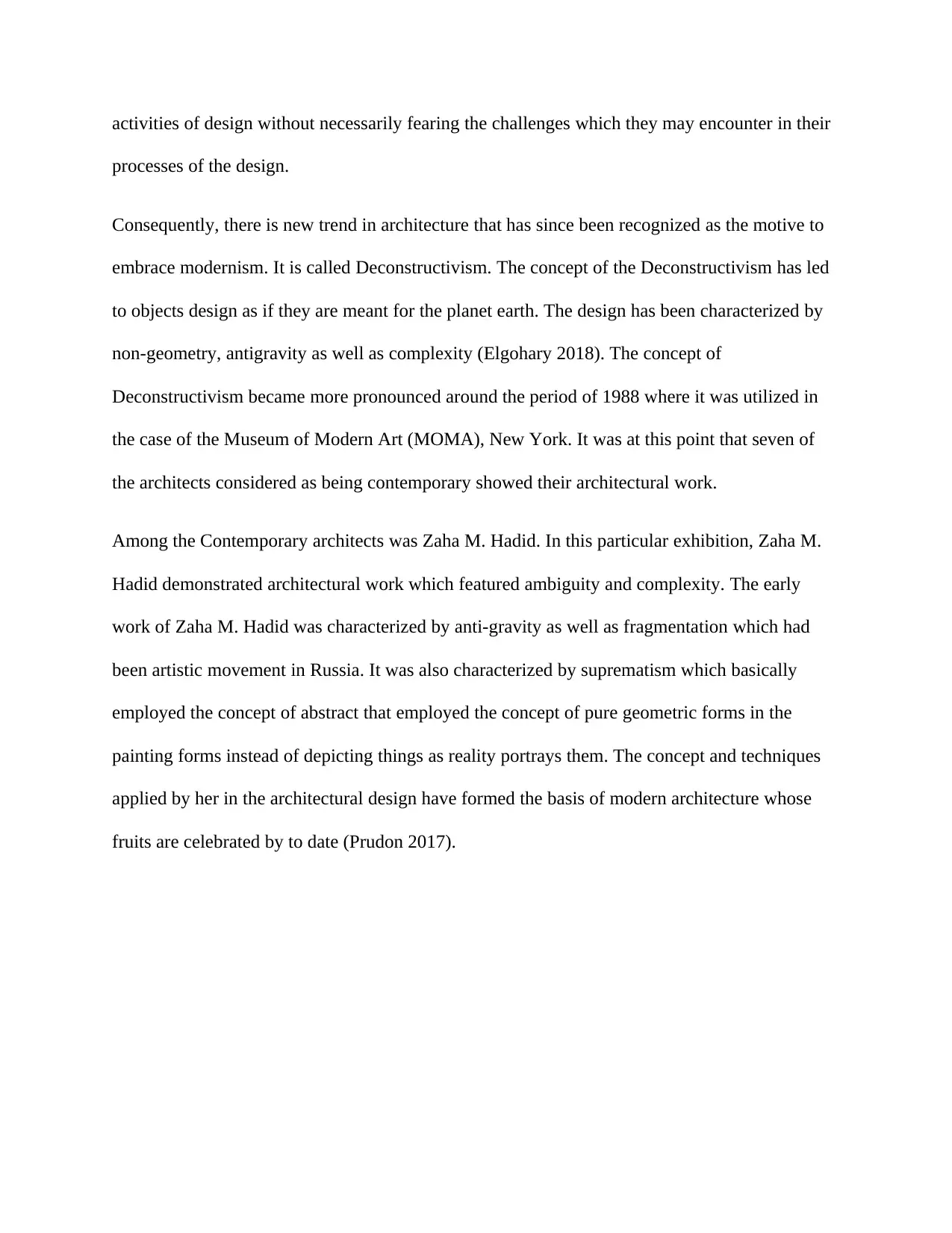
activities of design without necessarily fearing the challenges which they may encounter in their
processes of the design.
Consequently, there is new trend in architecture that has since been recognized as the motive to
embrace modernism. It is called Deconstructivism. The concept of the Deconstructivism has led
to objects design as if they are meant for the planet earth. The design has been characterized by
non-geometry, antigravity as well as complexity (Elgohary 2018). The concept of
Deconstructivism became more pronounced around the period of 1988 where it was utilized in
the case of the Museum of Modern Art (MOMA), New York. It was at this point that seven of
the architects considered as being contemporary showed their architectural work.
Among the Contemporary architects was Zaha M. Hadid. In this particular exhibition, Zaha M.
Hadid demonstrated architectural work which featured ambiguity and complexity. The early
work of Zaha M. Hadid was characterized by anti-gravity as well as fragmentation which had
been artistic movement in Russia. It was also characterized by suprematism which basically
employed the concept of abstract that employed the concept of pure geometric forms in the
painting forms instead of depicting things as reality portrays them. The concept and techniques
applied by her in the architectural design have formed the basis of modern architecture whose
fruits are celebrated by to date (Prudon 2017).
processes of the design.
Consequently, there is new trend in architecture that has since been recognized as the motive to
embrace modernism. It is called Deconstructivism. The concept of the Deconstructivism has led
to objects design as if they are meant for the planet earth. The design has been characterized by
non-geometry, antigravity as well as complexity (Elgohary 2018). The concept of
Deconstructivism became more pronounced around the period of 1988 where it was utilized in
the case of the Museum of Modern Art (MOMA), New York. It was at this point that seven of
the architects considered as being contemporary showed their architectural work.
Among the Contemporary architects was Zaha M. Hadid. In this particular exhibition, Zaha M.
Hadid demonstrated architectural work which featured ambiguity and complexity. The early
work of Zaha M. Hadid was characterized by anti-gravity as well as fragmentation which had
been artistic movement in Russia. It was also characterized by suprematism which basically
employed the concept of abstract that employed the concept of pure geometric forms in the
painting forms instead of depicting things as reality portrays them. The concept and techniques
applied by her in the architectural design have formed the basis of modern architecture whose
fruits are celebrated by to date (Prudon 2017).
⊘ This is a preview!⊘
Do you want full access?
Subscribe today to unlock all pages.

Trusted by 1+ million students worldwide
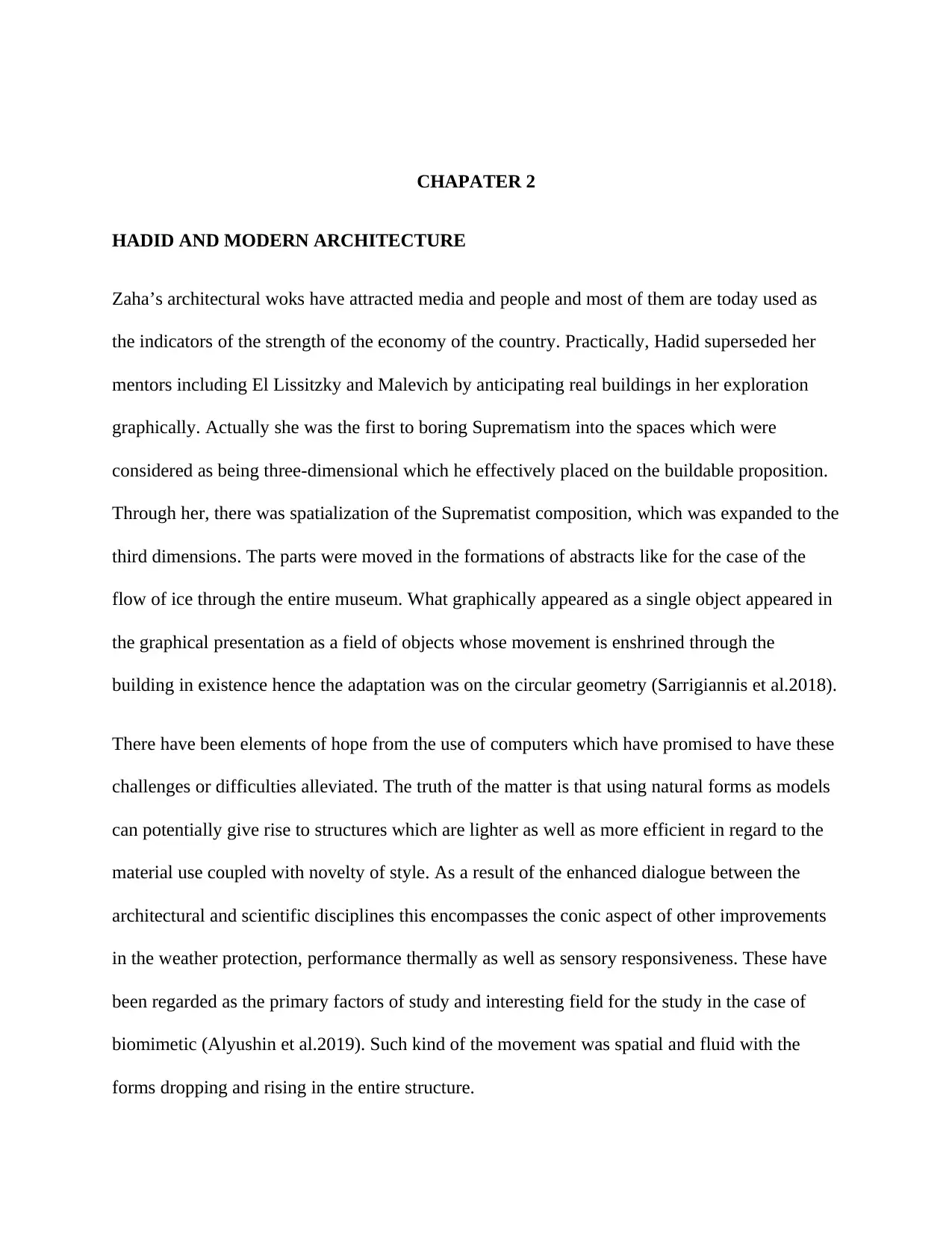
CHAPATER 2
HADID AND MODERN ARCHITECTURE
Zaha’s architectural woks have attracted media and people and most of them are today used as
the indicators of the strength of the economy of the country. Practically, Hadid superseded her
mentors including El Lissitzky and Malevich by anticipating real buildings in her exploration
graphically. Actually she was the first to boring Suprematism into the spaces which were
considered as being three-dimensional which he effectively placed on the buildable proposition.
Through her, there was spatialization of the Suprematist composition, which was expanded to the
third dimensions. The parts were moved in the formations of abstracts like for the case of the
flow of ice through the entire museum. What graphically appeared as a single object appeared in
the graphical presentation as a field of objects whose movement is enshrined through the
building in existence hence the adaptation was on the circular geometry (Sarrigiannis et al.2018).
There have been elements of hope from the use of computers which have promised to have these
challenges or difficulties alleviated. The truth of the matter is that using natural forms as models
can potentially give rise to structures which are lighter as well as more efficient in regard to the
material use coupled with novelty of style. As a result of the enhanced dialogue between the
architectural and scientific disciplines this encompasses the conic aspect of other improvements
in the weather protection, performance thermally as well as sensory responsiveness. These have
been regarded as the primary factors of study and interesting field for the study in the case of
biomimetic (Alyushin et al.2019). Such kind of the movement was spatial and fluid with the
forms dropping and rising in the entire structure.
HADID AND MODERN ARCHITECTURE
Zaha’s architectural woks have attracted media and people and most of them are today used as
the indicators of the strength of the economy of the country. Practically, Hadid superseded her
mentors including El Lissitzky and Malevich by anticipating real buildings in her exploration
graphically. Actually she was the first to boring Suprematism into the spaces which were
considered as being three-dimensional which he effectively placed on the buildable proposition.
Through her, there was spatialization of the Suprematist composition, which was expanded to the
third dimensions. The parts were moved in the formations of abstracts like for the case of the
flow of ice through the entire museum. What graphically appeared as a single object appeared in
the graphical presentation as a field of objects whose movement is enshrined through the
building in existence hence the adaptation was on the circular geometry (Sarrigiannis et al.2018).
There have been elements of hope from the use of computers which have promised to have these
challenges or difficulties alleviated. The truth of the matter is that using natural forms as models
can potentially give rise to structures which are lighter as well as more efficient in regard to the
material use coupled with novelty of style. As a result of the enhanced dialogue between the
architectural and scientific disciplines this encompasses the conic aspect of other improvements
in the weather protection, performance thermally as well as sensory responsiveness. These have
been regarded as the primary factors of study and interesting field for the study in the case of
biomimetic (Alyushin et al.2019). Such kind of the movement was spatial and fluid with the
forms dropping and rising in the entire structure.
Paraphrase This Document
Need a fresh take? Get an instant paraphrase of this document with our AI Paraphraser
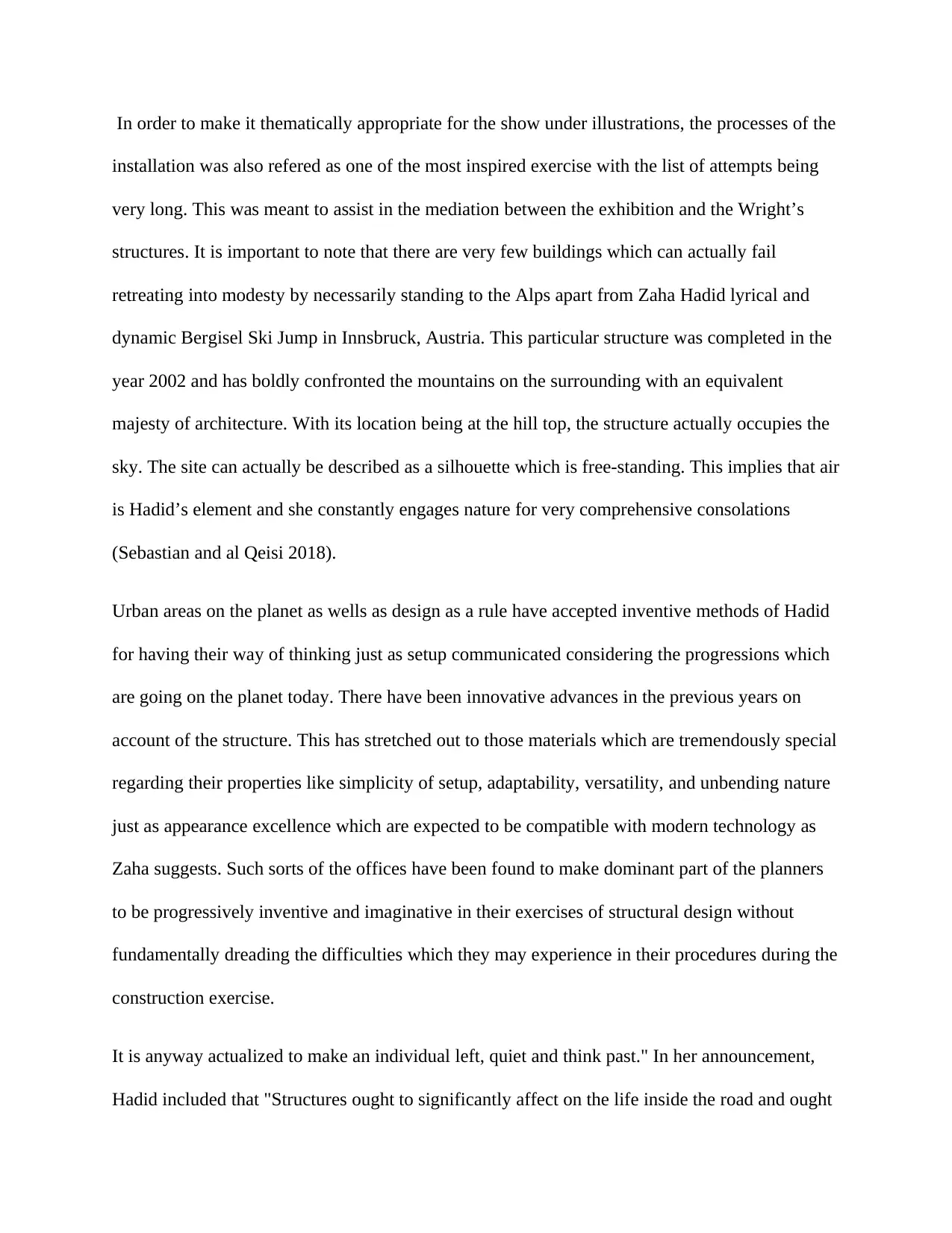
In order to make it thematically appropriate for the show under illustrations, the processes of the
installation was also refered as one of the most inspired exercise with the list of attempts being
very long. This was meant to assist in the mediation between the exhibition and the Wright’s
structures. It is important to note that there are very few buildings which can actually fail
retreating into modesty by necessarily standing to the Alps apart from Zaha Hadid lyrical and
dynamic Bergisel Ski Jump in Innsbruck, Austria. This particular structure was completed in the
year 2002 and has boldly confronted the mountains on the surrounding with an equivalent
majesty of architecture. With its location being at the hill top, the structure actually occupies the
sky. The site can actually be described as a silhouette which is free-standing. This implies that air
is Hadid’s element and she constantly engages nature for very comprehensive consolations
(Sebastian and al Qeisi 2018).
Urban areas on the planet as wells as design as a rule have accepted inventive methods of Hadid
for having their way of thinking just as setup communicated considering the progressions which
are going on the planet today. There have been innovative advances in the previous years on
account of the structure. This has stretched out to those materials which are tremendously special
regarding their properties like simplicity of setup, adaptability, versatility, and unbending nature
just as appearance excellence which are expected to be compatible with modern technology as
Zaha suggests. Such sorts of the offices have been found to make dominant part of the planners
to be progressively inventive and imaginative in their exercises of structural design without
fundamentally dreading the difficulties which they may experience in their procedures during the
construction exercise.
It is anyway actualized to make an individual left, quiet and think past." In her announcement,
Hadid included that "Structures ought to significantly affect on the life inside the road and ought
installation was also refered as one of the most inspired exercise with the list of attempts being
very long. This was meant to assist in the mediation between the exhibition and the Wright’s
structures. It is important to note that there are very few buildings which can actually fail
retreating into modesty by necessarily standing to the Alps apart from Zaha Hadid lyrical and
dynamic Bergisel Ski Jump in Innsbruck, Austria. This particular structure was completed in the
year 2002 and has boldly confronted the mountains on the surrounding with an equivalent
majesty of architecture. With its location being at the hill top, the structure actually occupies the
sky. The site can actually be described as a silhouette which is free-standing. This implies that air
is Hadid’s element and she constantly engages nature for very comprehensive consolations
(Sebastian and al Qeisi 2018).
Urban areas on the planet as wells as design as a rule have accepted inventive methods of Hadid
for having their way of thinking just as setup communicated considering the progressions which
are going on the planet today. There have been innovative advances in the previous years on
account of the structure. This has stretched out to those materials which are tremendously special
regarding their properties like simplicity of setup, adaptability, versatility, and unbending nature
just as appearance excellence which are expected to be compatible with modern technology as
Zaha suggests. Such sorts of the offices have been found to make dominant part of the planners
to be progressively inventive and imaginative in their exercises of structural design without
fundamentally dreading the difficulties which they may experience in their procedures during the
construction exercise.
It is anyway actualized to make an individual left, quiet and think past." In her announcement,
Hadid included that "Structures ought to significantly affect on the life inside the road and ought
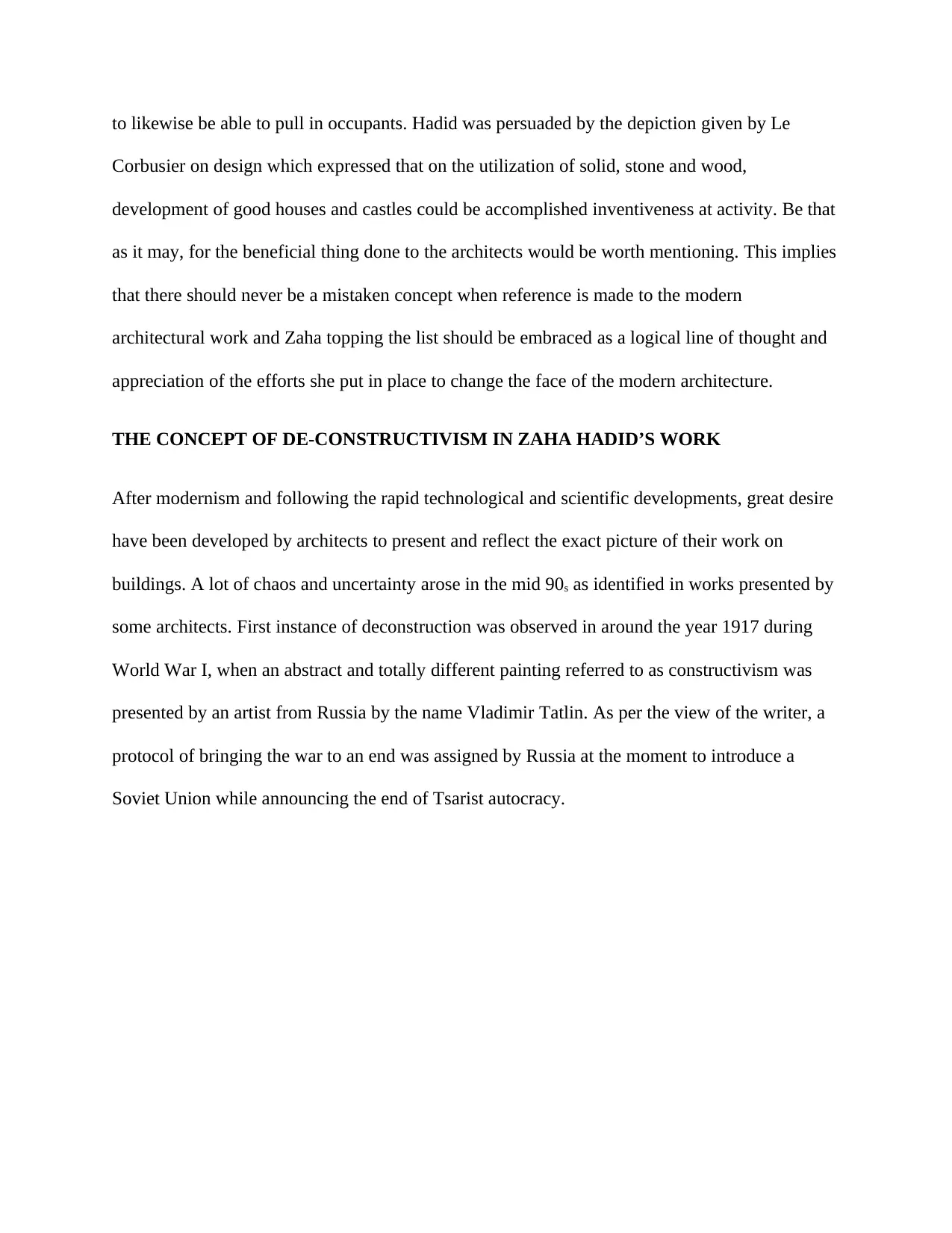
to likewise be able to pull in occupants. Hadid was persuaded by the depiction given by Le
Corbusier on design which expressed that on the utilization of solid, stone and wood,
development of good houses and castles could be accomplished inventiveness at activity. Be that
as it may, for the beneficial thing done to the architects would be worth mentioning. This implies
that there should never be a mistaken concept when reference is made to the modern
architectural work and Zaha topping the list should be embraced as a logical line of thought and
appreciation of the efforts she put in place to change the face of the modern architecture.
THE CONCEPT OF DE-CONSTRUCTIVISM IN ZAHA HADID’S WORK
After modernism and following the rapid technological and scientific developments, great desire
have been developed by architects to present and reflect the exact picture of their work on
buildings. A lot of chaos and uncertainty arose in the mid 90s as identified in works presented by
some architects. First instance of deconstruction was observed in around the year 1917 during
World War I, when an abstract and totally different painting referred to as constructivism was
presented by an artist from Russia by the name Vladimir Tatlin. As per the view of the writer, a
protocol of bringing the war to an end was assigned by Russia at the moment to introduce a
Soviet Union while announcing the end of Tsarist autocracy.
Corbusier on design which expressed that on the utilization of solid, stone and wood,
development of good houses and castles could be accomplished inventiveness at activity. Be that
as it may, for the beneficial thing done to the architects would be worth mentioning. This implies
that there should never be a mistaken concept when reference is made to the modern
architectural work and Zaha topping the list should be embraced as a logical line of thought and
appreciation of the efforts she put in place to change the face of the modern architecture.
THE CONCEPT OF DE-CONSTRUCTIVISM IN ZAHA HADID’S WORK
After modernism and following the rapid technological and scientific developments, great desire
have been developed by architects to present and reflect the exact picture of their work on
buildings. A lot of chaos and uncertainty arose in the mid 90s as identified in works presented by
some architects. First instance of deconstruction was observed in around the year 1917 during
World War I, when an abstract and totally different painting referred to as constructivism was
presented by an artist from Russia by the name Vladimir Tatlin. As per the view of the writer, a
protocol of bringing the war to an end was assigned by Russia at the moment to introduce a
Soviet Union while announcing the end of Tsarist autocracy.
⊘ This is a preview!⊘
Do you want full access?
Subscribe today to unlock all pages.

Trusted by 1+ million students worldwide
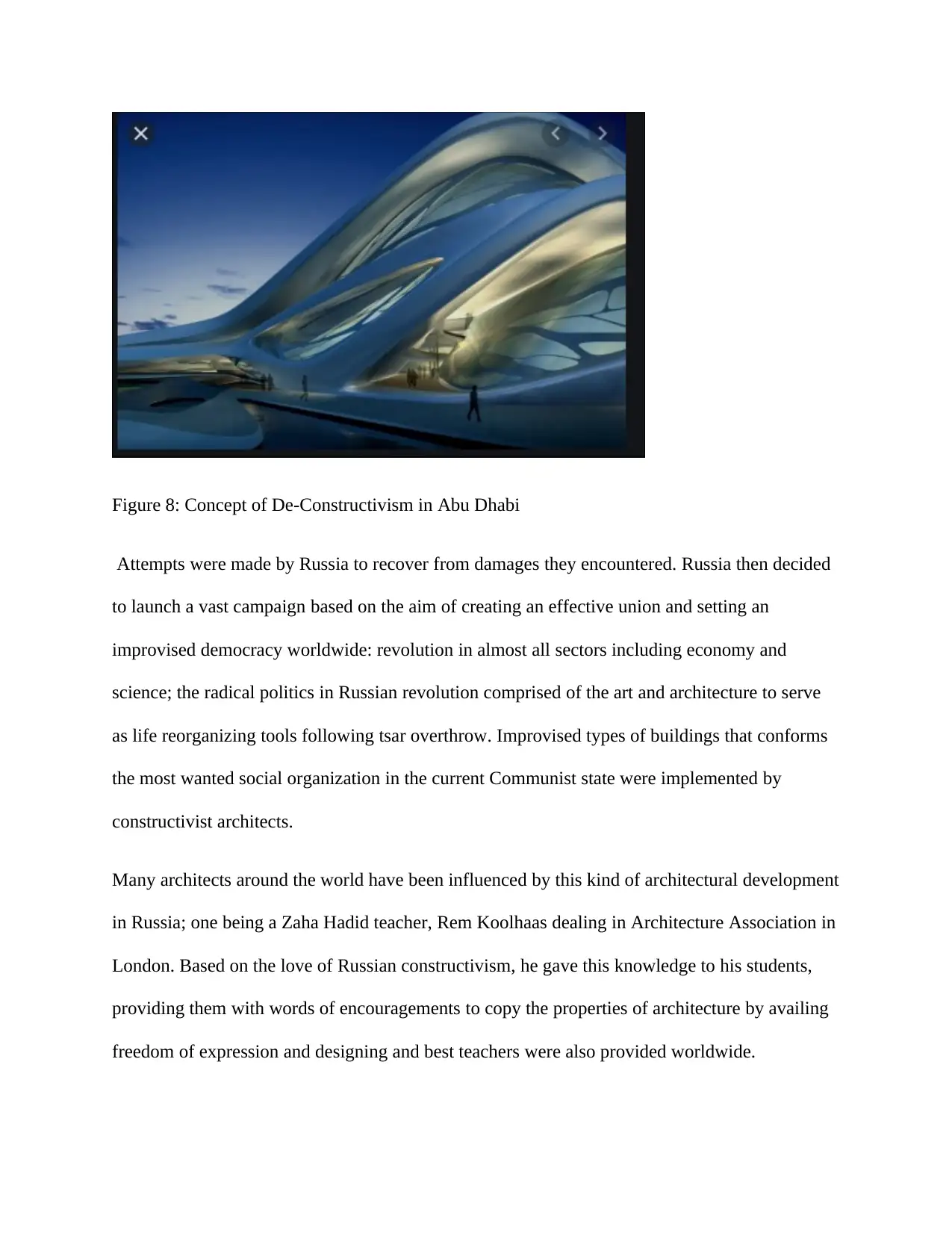
Figure 8: Concept of De-Constructivism in Abu Dhabi
Attempts were made by Russia to recover from damages they encountered. Russia then decided
to launch a vast campaign based on the aim of creating an effective union and setting an
improvised democracy worldwide: revolution in almost all sectors including economy and
science; the radical politics in Russian revolution comprised of the art and architecture to serve
as life reorganizing tools following tsar overthrow. Improvised types of buildings that conforms
the most wanted social organization in the current Communist state were implemented by
constructivist architects.
Many architects around the world have been influenced by this kind of architectural development
in Russia; one being a Zaha Hadid teacher, Rem Koolhaas dealing in Architecture Association in
London. Based on the love of Russian constructivism, he gave this knowledge to his students,
providing them with words of encouragements to copy the properties of architecture by availing
freedom of expression and designing and best teachers were also provided worldwide.
Attempts were made by Russia to recover from damages they encountered. Russia then decided
to launch a vast campaign based on the aim of creating an effective union and setting an
improvised democracy worldwide: revolution in almost all sectors including economy and
science; the radical politics in Russian revolution comprised of the art and architecture to serve
as life reorganizing tools following tsar overthrow. Improvised types of buildings that conforms
the most wanted social organization in the current Communist state were implemented by
constructivist architects.
Many architects around the world have been influenced by this kind of architectural development
in Russia; one being a Zaha Hadid teacher, Rem Koolhaas dealing in Architecture Association in
London. Based on the love of Russian constructivism, he gave this knowledge to his students,
providing them with words of encouragements to copy the properties of architecture by availing
freedom of expression and designing and best teachers were also provided worldwide.
Paraphrase This Document
Need a fresh take? Get an instant paraphrase of this document with our AI Paraphraser
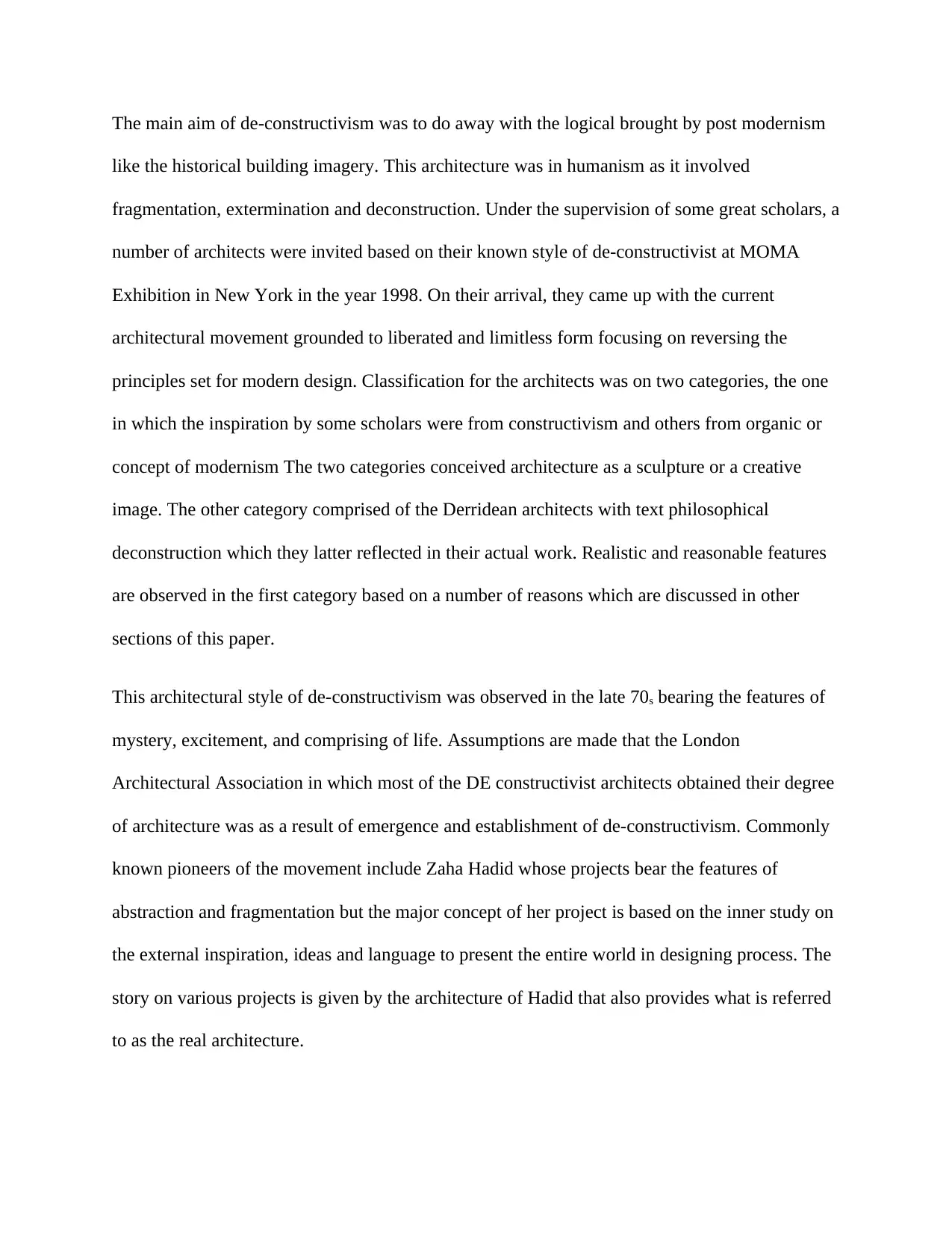
The main aim of de-constructivism was to do away with the logical brought by post modernism
like the historical building imagery. This architecture was in humanism as it involved
fragmentation, extermination and deconstruction. Under the supervision of some great scholars, a
number of architects were invited based on their known style of de-constructivist at MOMA
Exhibition in New York in the year 1998. On their arrival, they came up with the current
architectural movement grounded to liberated and limitless form focusing on reversing the
principles set for modern design. Classification for the architects was on two categories, the one
in which the inspiration by some scholars were from constructivism and others from organic or
concept of modernism The two categories conceived architecture as a sculpture or a creative
image. The other category comprised of the Derridean architects with text philosophical
deconstruction which they latter reflected in their actual work. Realistic and reasonable features
are observed in the first category based on a number of reasons which are discussed in other
sections of this paper.
This architectural style of de-constructivism was observed in the late 70s bearing the features of
mystery, excitement, and comprising of life. Assumptions are made that the London
Architectural Association in which most of the DE constructivist architects obtained their degree
of architecture was as a result of emergence and establishment of de-constructivism. Commonly
known pioneers of the movement include Zaha Hadid whose projects bear the features of
abstraction and fragmentation but the major concept of her project is based on the inner study on
the external inspiration, ideas and language to present the entire world in designing process. The
story on various projects is given by the architecture of Hadid that also provides what is referred
to as the real architecture.
like the historical building imagery. This architecture was in humanism as it involved
fragmentation, extermination and deconstruction. Under the supervision of some great scholars, a
number of architects were invited based on their known style of de-constructivist at MOMA
Exhibition in New York in the year 1998. On their arrival, they came up with the current
architectural movement grounded to liberated and limitless form focusing on reversing the
principles set for modern design. Classification for the architects was on two categories, the one
in which the inspiration by some scholars were from constructivism and others from organic or
concept of modernism The two categories conceived architecture as a sculpture or a creative
image. The other category comprised of the Derridean architects with text philosophical
deconstruction which they latter reflected in their actual work. Realistic and reasonable features
are observed in the first category based on a number of reasons which are discussed in other
sections of this paper.
This architectural style of de-constructivism was observed in the late 70s bearing the features of
mystery, excitement, and comprising of life. Assumptions are made that the London
Architectural Association in which most of the DE constructivist architects obtained their degree
of architecture was as a result of emergence and establishment of de-constructivism. Commonly
known pioneers of the movement include Zaha Hadid whose projects bear the features of
abstraction and fragmentation but the major concept of her project is based on the inner study on
the external inspiration, ideas and language to present the entire world in designing process. The
story on various projects is given by the architecture of Hadid that also provides what is referred
to as the real architecture.
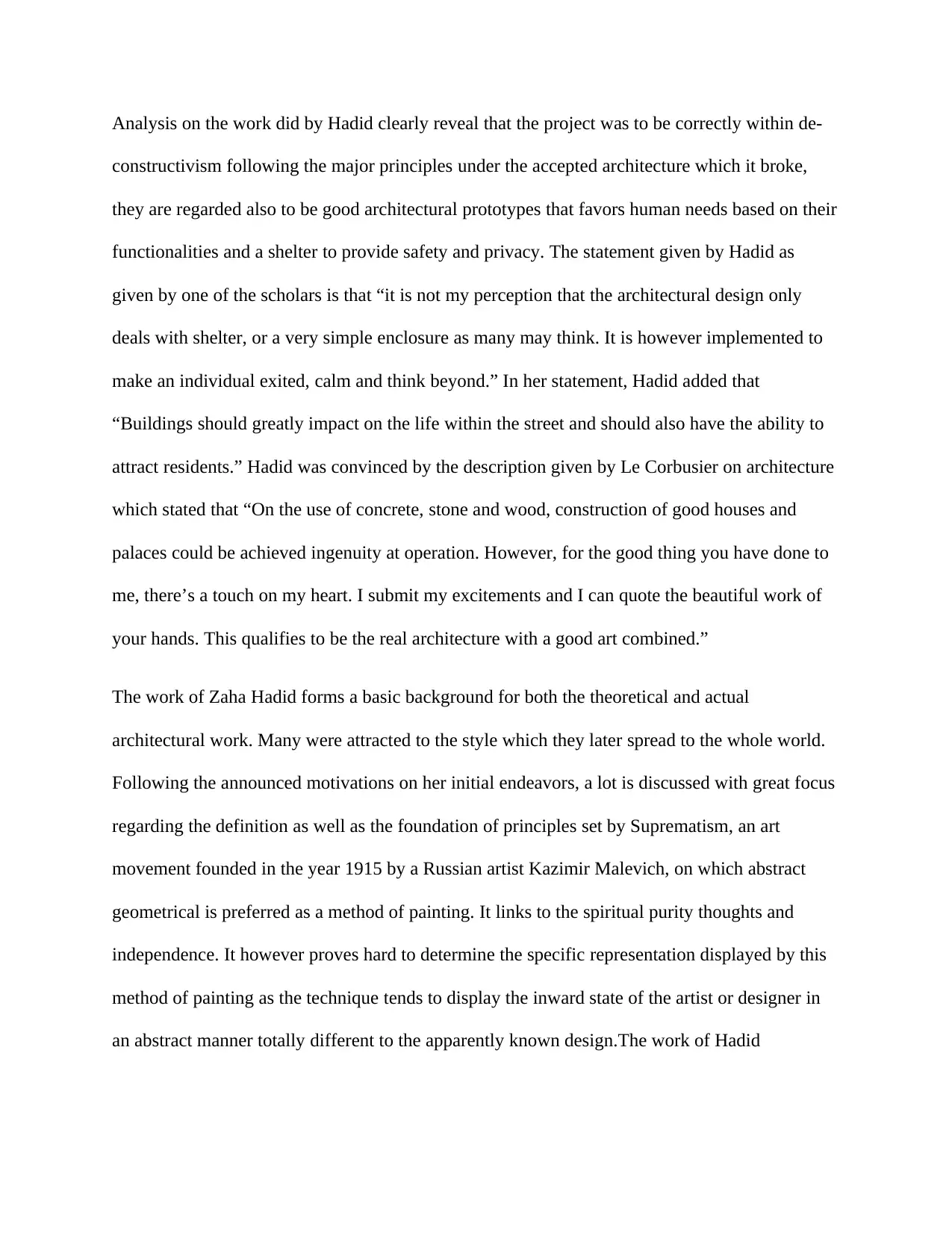
Analysis on the work did by Hadid clearly reveal that the project was to be correctly within de-
constructivism following the major principles under the accepted architecture which it broke,
they are regarded also to be good architectural prototypes that favors human needs based on their
functionalities and a shelter to provide safety and privacy. The statement given by Hadid as
given by one of the scholars is that “it is not my perception that the architectural design only
deals with shelter, or a very simple enclosure as many may think. It is however implemented to
make an individual exited, calm and think beyond.” In her statement, Hadid added that
“Buildings should greatly impact on the life within the street and should also have the ability to
attract residents.” Hadid was convinced by the description given by Le Corbusier on architecture
which stated that “On the use of concrete, stone and wood, construction of good houses and
palaces could be achieved ingenuity at operation. However, for the good thing you have done to
me, there’s a touch on my heart. I submit my excitements and I can quote the beautiful work of
your hands. This qualifies to be the real architecture with a good art combined.”
The work of Zaha Hadid forms a basic background for both the theoretical and actual
architectural work. Many were attracted to the style which they later spread to the whole world.
Following the announced motivations on her initial endeavors, a lot is discussed with great focus
regarding the definition as well as the foundation of principles set by Suprematism, an art
movement founded in the year 1915 by a Russian artist Kazimir Malevich, on which abstract
geometrical is preferred as a method of painting. It links to the spiritual purity thoughts and
independence. It however proves hard to determine the specific representation displayed by this
method of painting as the technique tends to display the inward state of the artist or designer in
an abstract manner totally different to the apparently known design.The work of Hadid
constructivism following the major principles under the accepted architecture which it broke,
they are regarded also to be good architectural prototypes that favors human needs based on their
functionalities and a shelter to provide safety and privacy. The statement given by Hadid as
given by one of the scholars is that “it is not my perception that the architectural design only
deals with shelter, or a very simple enclosure as many may think. It is however implemented to
make an individual exited, calm and think beyond.” In her statement, Hadid added that
“Buildings should greatly impact on the life within the street and should also have the ability to
attract residents.” Hadid was convinced by the description given by Le Corbusier on architecture
which stated that “On the use of concrete, stone and wood, construction of good houses and
palaces could be achieved ingenuity at operation. However, for the good thing you have done to
me, there’s a touch on my heart. I submit my excitements and I can quote the beautiful work of
your hands. This qualifies to be the real architecture with a good art combined.”
The work of Zaha Hadid forms a basic background for both the theoretical and actual
architectural work. Many were attracted to the style which they later spread to the whole world.
Following the announced motivations on her initial endeavors, a lot is discussed with great focus
regarding the definition as well as the foundation of principles set by Suprematism, an art
movement founded in the year 1915 by a Russian artist Kazimir Malevich, on which abstract
geometrical is preferred as a method of painting. It links to the spiritual purity thoughts and
independence. It however proves hard to determine the specific representation displayed by this
method of painting as the technique tends to display the inward state of the artist or designer in
an abstract manner totally different to the apparently known design.The work of Hadid
⊘ This is a preview!⊘
Do you want full access?
Subscribe today to unlock all pages.

Trusted by 1+ million students worldwide
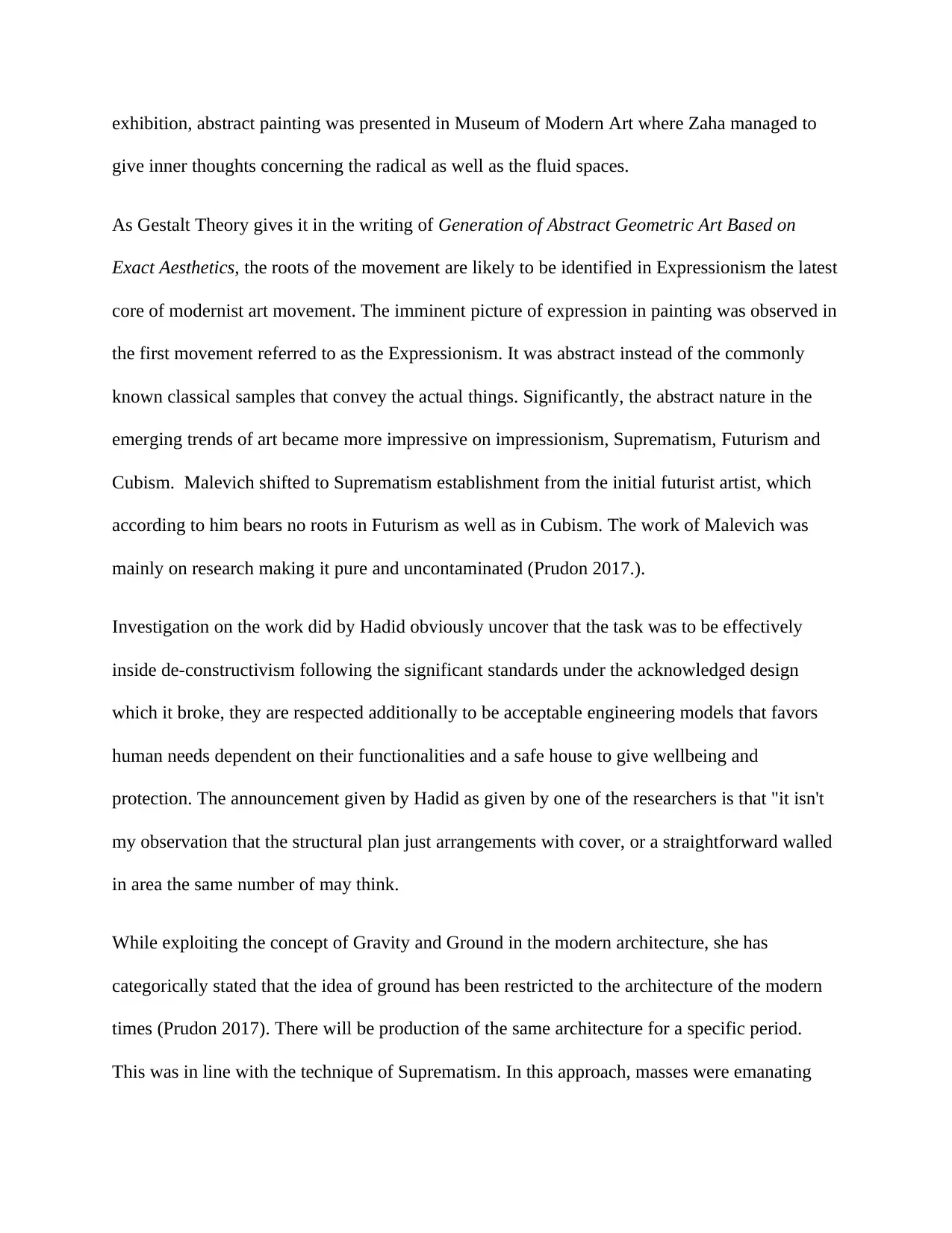
exhibition, abstract painting was presented in Museum of Modern Art where Zaha managed to
give inner thoughts concerning the radical as well as the fluid spaces.
As Gestalt Theory gives it in the writing of Generation of Abstract Geometric Art Based on
Exact Aesthetics, the roots of the movement are likely to be identified in Expressionism the latest
core of modernist art movement. The imminent picture of expression in painting was observed in
the first movement referred to as the Expressionism. It was abstract instead of the commonly
known classical samples that convey the actual things. Significantly, the abstract nature in the
emerging trends of art became more impressive on impressionism, Suprematism, Futurism and
Cubism. Malevich shifted to Suprematism establishment from the initial futurist artist, which
according to him bears no roots in Futurism as well as in Cubism. The work of Malevich was
mainly on research making it pure and uncontaminated (Prudon 2017.).
Investigation on the work did by Hadid obviously uncover that the task was to be effectively
inside de-constructivism following the significant standards under the acknowledged design
which it broke, they are respected additionally to be acceptable engineering models that favors
human needs dependent on their functionalities and a safe house to give wellbeing and
protection. The announcement given by Hadid as given by one of the researchers is that "it isn't
my observation that the structural plan just arrangements with cover, or a straightforward walled
in area the same number of may think.
While exploiting the concept of Gravity and Ground in the modern architecture, she has
categorically stated that the idea of ground has been restricted to the architecture of the modern
times (Prudon 2017). There will be production of the same architecture for a specific period.
This was in line with the technique of Suprematism. In this approach, masses were emanating
give inner thoughts concerning the radical as well as the fluid spaces.
As Gestalt Theory gives it in the writing of Generation of Abstract Geometric Art Based on
Exact Aesthetics, the roots of the movement are likely to be identified in Expressionism the latest
core of modernist art movement. The imminent picture of expression in painting was observed in
the first movement referred to as the Expressionism. It was abstract instead of the commonly
known classical samples that convey the actual things. Significantly, the abstract nature in the
emerging trends of art became more impressive on impressionism, Suprematism, Futurism and
Cubism. Malevich shifted to Suprematism establishment from the initial futurist artist, which
according to him bears no roots in Futurism as well as in Cubism. The work of Malevich was
mainly on research making it pure and uncontaminated (Prudon 2017.).
Investigation on the work did by Hadid obviously uncover that the task was to be effectively
inside de-constructivism following the significant standards under the acknowledged design
which it broke, they are respected additionally to be acceptable engineering models that favors
human needs dependent on their functionalities and a safe house to give wellbeing and
protection. The announcement given by Hadid as given by one of the researchers is that "it isn't
my observation that the structural plan just arrangements with cover, or a straightforward walled
in area the same number of may think.
While exploiting the concept of Gravity and Ground in the modern architecture, she has
categorically stated that the idea of ground has been restricted to the architecture of the modern
times (Prudon 2017). There will be production of the same architecture for a specific period.
This was in line with the technique of Suprematism. In this approach, masses were emanating
Paraphrase This Document
Need a fresh take? Get an instant paraphrase of this document with our AI Paraphraser
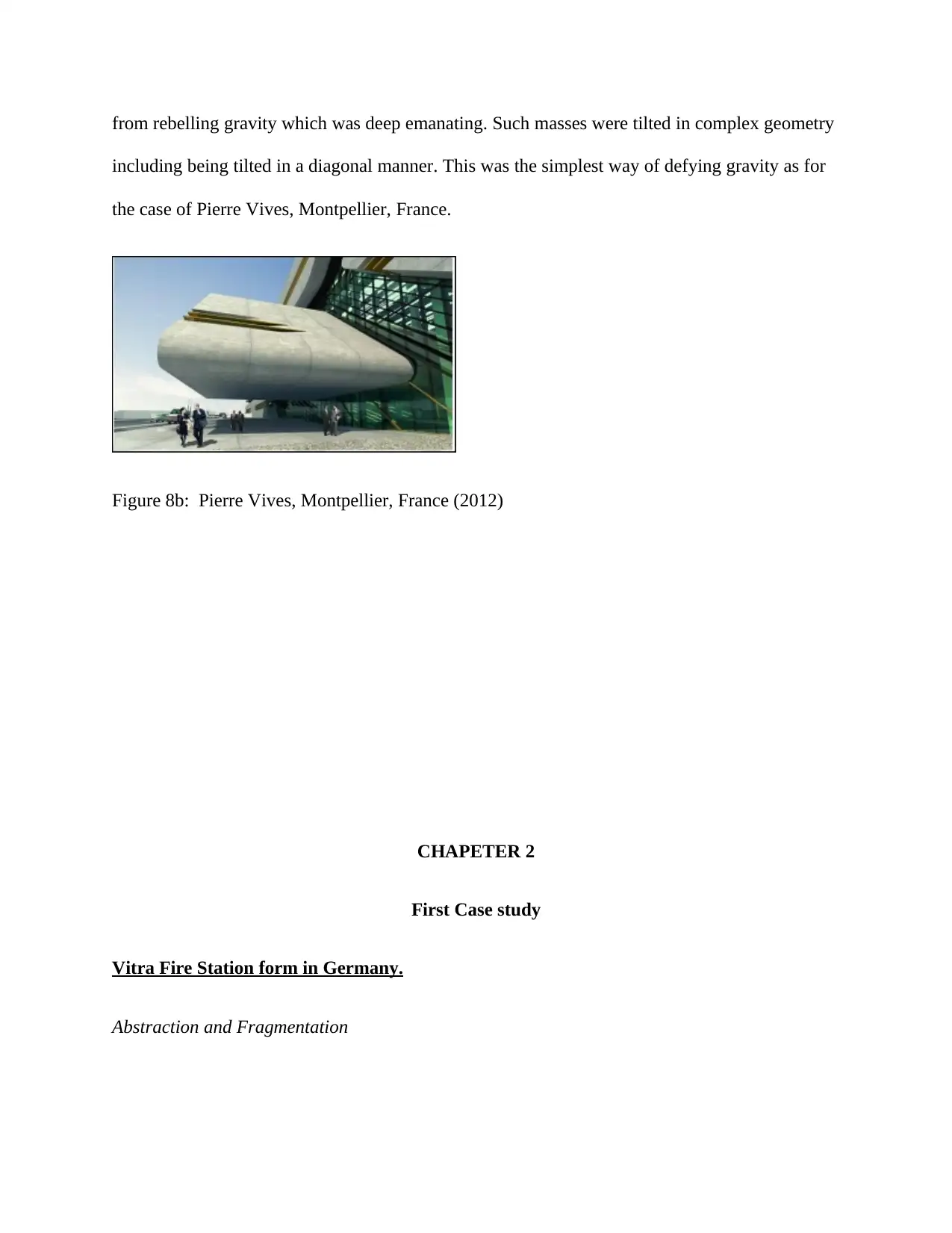
from rebelling gravity which was deep emanating. Such masses were tilted in complex geometry
including being tilted in a diagonal manner. This was the simplest way of defying gravity as for
the case of Pierre Vives, Montpellier, France.
Figure 8b: Pierre Vives, Montpellier, France (2012)
CHAPETER 2
First Case study
Vitra Fire Station form in Germany.
Abstraction and Fragmentation
including being tilted in a diagonal manner. This was the simplest way of defying gravity as for
the case of Pierre Vives, Montpellier, France.
Figure 8b: Pierre Vives, Montpellier, France (2012)
CHAPETER 2
First Case study
Vitra Fire Station form in Germany.
Abstraction and Fragmentation
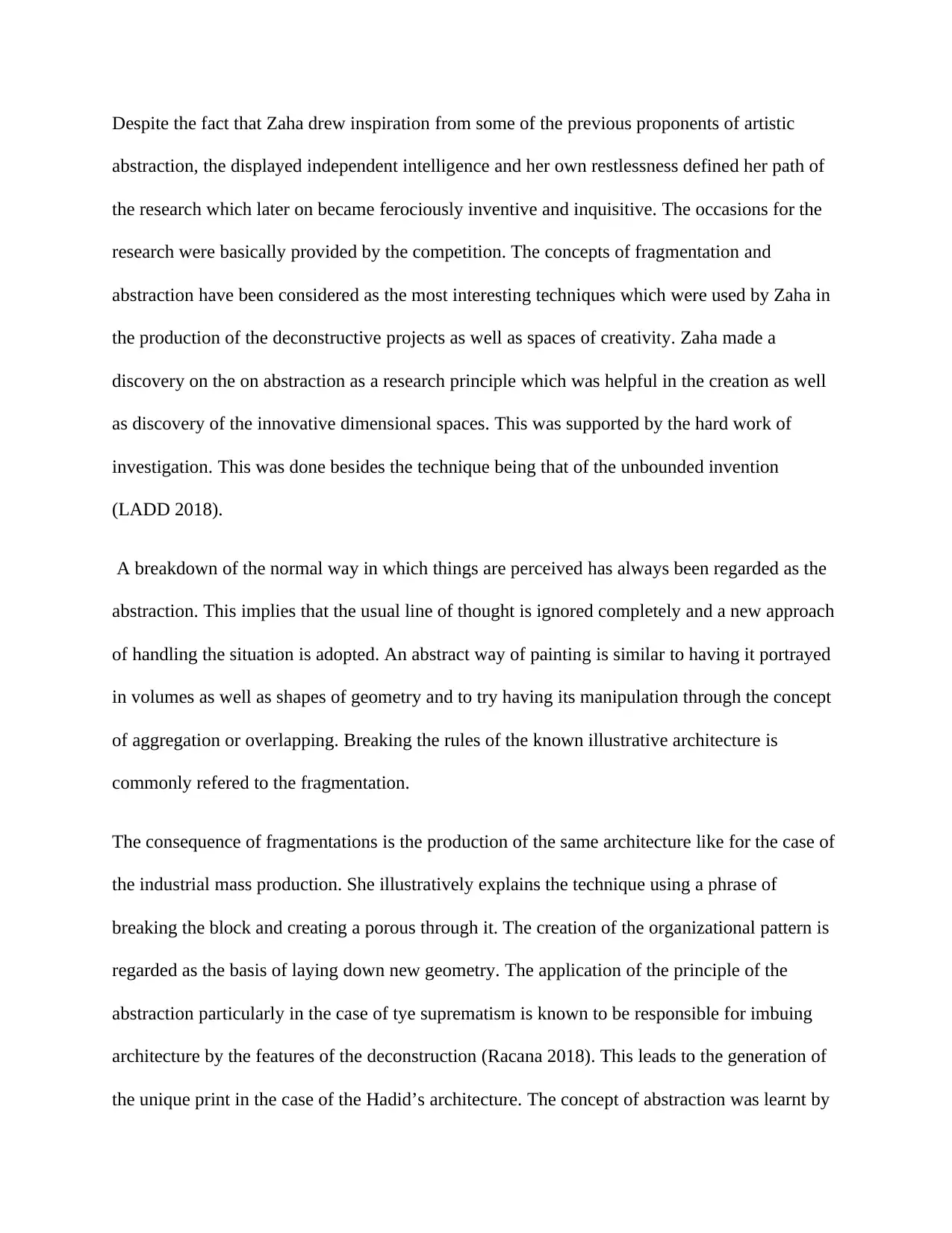
Despite the fact that Zaha drew inspiration from some of the previous proponents of artistic
abstraction, the displayed independent intelligence and her own restlessness defined her path of
the research which later on became ferociously inventive and inquisitive. The occasions for the
research were basically provided by the competition. The concepts of fragmentation and
abstraction have been considered as the most interesting techniques which were used by Zaha in
the production of the deconstructive projects as well as spaces of creativity. Zaha made a
discovery on the on abstraction as a research principle which was helpful in the creation as well
as discovery of the innovative dimensional spaces. This was supported by the hard work of
investigation. This was done besides the technique being that of the unbounded invention
(LADD 2018).
A breakdown of the normal way in which things are perceived has always been regarded as the
abstraction. This implies that the usual line of thought is ignored completely and a new approach
of handling the situation is adopted. An abstract way of painting is similar to having it portrayed
in volumes as well as shapes of geometry and to try having its manipulation through the concept
of aggregation or overlapping. Breaking the rules of the known illustrative architecture is
commonly refered to the fragmentation.
The consequence of fragmentations is the production of the same architecture like for the case of
the industrial mass production. She illustratively explains the technique using a phrase of
breaking the block and creating a porous through it. The creation of the organizational pattern is
regarded as the basis of laying down new geometry. The application of the principle of the
abstraction particularly in the case of tye suprematism is known to be responsible for imbuing
architecture by the features of the deconstruction (Racana 2018). This leads to the generation of
the unique print in the case of the Hadid’s architecture. The concept of abstraction was learnt by
abstraction, the displayed independent intelligence and her own restlessness defined her path of
the research which later on became ferociously inventive and inquisitive. The occasions for the
research were basically provided by the competition. The concepts of fragmentation and
abstraction have been considered as the most interesting techniques which were used by Zaha in
the production of the deconstructive projects as well as spaces of creativity. Zaha made a
discovery on the on abstraction as a research principle which was helpful in the creation as well
as discovery of the innovative dimensional spaces. This was supported by the hard work of
investigation. This was done besides the technique being that of the unbounded invention
(LADD 2018).
A breakdown of the normal way in which things are perceived has always been regarded as the
abstraction. This implies that the usual line of thought is ignored completely and a new approach
of handling the situation is adopted. An abstract way of painting is similar to having it portrayed
in volumes as well as shapes of geometry and to try having its manipulation through the concept
of aggregation or overlapping. Breaking the rules of the known illustrative architecture is
commonly refered to the fragmentation.
The consequence of fragmentations is the production of the same architecture like for the case of
the industrial mass production. She illustratively explains the technique using a phrase of
breaking the block and creating a porous through it. The creation of the organizational pattern is
regarded as the basis of laying down new geometry. The application of the principle of the
abstraction particularly in the case of tye suprematism is known to be responsible for imbuing
architecture by the features of the deconstruction (Racana 2018). This leads to the generation of
the unique print in the case of the Hadid’s architecture. The concept of abstraction was learnt by
⊘ This is a preview!⊘
Do you want full access?
Subscribe today to unlock all pages.

Trusted by 1+ million students worldwide
1 out of 32
Related Documents
Your All-in-One AI-Powered Toolkit for Academic Success.
+13062052269
info@desklib.com
Available 24*7 on WhatsApp / Email
![[object Object]](/_next/static/media/star-bottom.7253800d.svg)
Unlock your academic potential
Copyright © 2020–2025 A2Z Services. All Rights Reserved. Developed and managed by ZUCOL.





